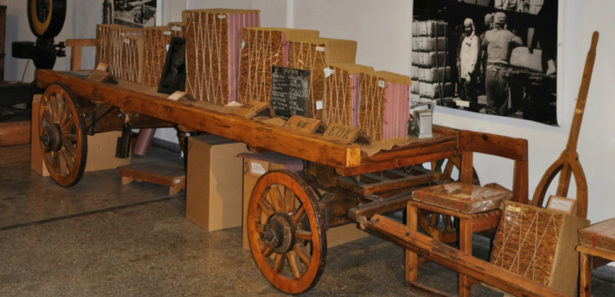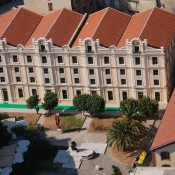Two centuries following the heyday of the processing and trading of tobacco in Kavala, locals and hundreds of visitors cannot forget the agricultural product that defined the town’s social and economic history. The historical evolution of modern Kavala is not to be found in its beautiful beaches or the facades of the few remaining mansions, neither in the medieval aqueduct of Kamares, nor in the castle at the top of the old town on the Panaghia peninsula. It is well hidden in its neighbourhoods; its narrow streets that lead to places where thousands of people worked and sweated over the toga, straps and chests containing different varieties of tobacco.
One can literally smell the town’s history as one walks along the cobbled streets among the impressive stone tobacco shops which hosted men and women of all ages and, in earlier days, of all nationalities and religions, since tobacco processing in Kavala dates from 1850, when this town and all of Northern Greece was under Turkish occupation. Today there are only a handful of tobacco workers in the town, employed in the remaining tobacco companies that have modern equipment. For some years now the town has picked up momentum, relying however on different methods for its growth.
The remaining tobacco warehouses are deserted and silent, but they emanate a certain grandeur which adds a little beauty among the unattractive apartment blocks. These warehouses alone, together with the spoken narratives of old tobacco workers, remind one today that there was a time here when tobacco work was a way of life both exhausting and glorious.
It was Kavala’s close link with the processing and trading of tobacco that gave rise to the necessity of exploring this significant aspect of local history. Thus from time to time, many scholars, researchers and journalists became interested in this matter and published books or articles, while many locals caught on and started donating objects, photographs and documents to Kavala’s Municipal Museum.
The price of growth
The first significant step was taken on April 5 2003, with the opening of the Municipal Museum of Tobacco which is temporarily housed on the ground floor of the premises of the former Greek Tobacco Organization. The Municipal Museum of Tobacco, a thematic and unusual museum, is a very small tribute to the hundreds of thousands of tobacco workers and their families who worked so hard and even risked their lives at times.
The thousands of visits to the Municipal Museum of Tobacco all the year round reveal its uniqueness as one of the few such museums existing not just in Greece but throughout the whole of Europe. The key role played by tobacco in their lives is revealed by the fact that dozens of both well known and anonymous descendants of big tobacco companies, tobacco trading societies and clubs from all over Greece, as well as simple tobacco workers have to date donated to the Municipal Museum of Tobacco photographs, documents, rare archive material, old tobacco processing machines, handicrafts made of tobacco leaf, antique furniture, books, workers’ registers, and much more. For very many years it had been an integral part of their everyday life, and so their wish was to keep these moments alive for ever, however difficult they may have been.
A great economic boom
There is no doubt that the processing and trading of tobacco gave a great boost to the city beginning in the early 1920s. Important factors were the demand for Macedonian tobacco, the presence of the refugees who came in 1922 significantly increasing the labour force, the port of Kavala and the presence in the town of many consular authorities from all major European cities. It is therefore no accident that Kavala became the largest tobacco processing centre in Greece and the Balkans.
At least twenty foreign companies and thirty Greek tobacco companies were active in Kavala during this period. 15,000 male and female workers were employed in the processing of tobacco, which was 80% of the town’s workforce, while 50% of the country’s tobacco workers were in Kavala at that time. The above facts fully justify the description “Mecca of Tobacco” that had been given to the town in the past.
Tobacco merchants created huge fortunes in a very short space of time, while conditions were hard for tobacco workers. Their main problems were tuberculosis caused by enclosed sunless work places, as well as the job being seasonal, since processing lasts from spring to autumn.
The history of tobacco and the contribution this specific crop made to the place’s growth is reflected in every corner of the exhibition space. The visitors’ attention however is definitely captured by the recreation of traditional methods of tobacco processing with the construction of replicas for the exhibition. It is a specialty that is becoming obsolete and the Municipal Museum of Tobacco is the only institution in Europe that continues this traditional technique. Lastly, the operation of machinery for the commercial processing of tobacco in the exhibition area is a unique experience for the visitor.





